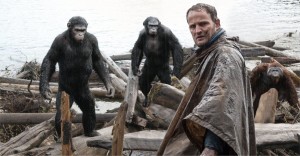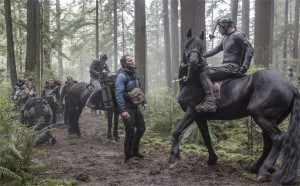The apes are back! J.P. gives his take on the ongoing story of Apes leader Caesar (Andy Serkis) and his relationship with the human survivors.
Dawn Of The Planet of the Apes
(20th Century Fox)
Directed By: Matt Reeves
Produced By: Peter Chernin, Dylan Clark, Rick Jaffa, Amanda Silver
Starring: Andy Serkis, Jason Clarke, Gary Oldman, Keri Russell, Toby Kebbell, Kodi Smit-McPhee, Enrique Murciano, Kirk Acevedo
Studio Synopsis:
In DAWN OF THE PLANET OF THE APES a growing nation of genetically evolved apes, led by Caesar, are threatened by a band of human survivors of the devastating virus unleashed a decade earlier. They reach a fragile peace, but it proves short-lived, as both sides are brought to the brink of a war that will determine who will emerge as Earth’s dominant species.
J.P.’s Take: (Revised)
As predicted towards the end of “Rise of the Planet of the Apes,” an outbreak of Simian Flu causes a pandemic sparking the downfall of human civilization. As you may know such chaos began with a Chimpanzee named Caesar (Andy Serkis). Being the test subject at the Gen-Sys lab in San Francisco, Caesar was administered an experimental drug ALZ-112; the first step in curing neurological diseases. However in Caesar’s case, the result was increased intelligence. Will Rodman, a biotechnologist at Gen-Sys (played by James Franco in “Rise”), realized Caesar’s aptitude in comprehending language and human behavior. He became his surrogate “father” and raised him. With his new found awareness, Caesar was astute to the inhuman treatment he’s received, as well as his brothers and sisters. “Rise” focused on his ascension to heroism as contributed by his pain and suffering at the hands of humankind. You may recall the momentous scene in the forerunner where Caesar lead his fellow simians in an escape from the lab. They stormed the Golden Gate Bridge in a hostile take over before retreating into the woods of Northern California.

In the sequel, “Dawn” is that day of reckoning, opening with a series of news bits exhibiting the devastation after battling both the virus and the apes that carried it. The film takes place a decade later as the two factions: the human survivors and evolved apes struggle to keep the peace between them. Director Matt Reeves (“Cloverfield,” “Let Me In”) with writers Rick Jaffa (“Rise of the Planet of the Apes,” upcoming “Avatar” sequels), Amanda Silver (“The Relic,” upcoming “Avatar” sequels) and Mark Bomback (“Unstoppable,” “The Wolverine”) construct a story laced with social commentary that is emotionally grabbing and intelligently scripted. This newest incorporation does away with the chucklesome story thread of the 60’s/70’s flicks, while drawing on political angles found in the real world. There is an inner war being fought within both groups, which threatens to erupt in another war.
What drives the plot here is the discovery of similar dynamics within each of the entities. A scene in the beginning of the film finds Carver (Kirk Acevedo), a member of a human scouting troupe, wandering around in the woods. He stumbles upon a group of apes on a hunting exercise and shoots one of them. This ignites a stand off with the remainder of the human group led by Malcolm (Jason Clarke) and apes; prompting Koba (Toby Kebbell), a Bonobo General, to alert Caesar. Because of Caesar’s human upbringing, he is much more sympathetic to their efforts. Unwilling to fight them, he instead shouts…GO, DON’T COME BACK! This startles the humans for which Malcolm assures Caesar this was all just a misunderstanding. There is an especially formidable scene that follows where a legion of apes march down from their woodland home to the ruins of San Francisco. Malcolm steps forward to his dismay, as he explains that they were up there to restore power to a downed hydroelectric plant. The human’s power reserves were running low an all they want is to get the plant running so they can live in comfort and peace. Again, Caesar warns them not to revisit the woods.
This matter prays on Caesar’s sympathies knowing what he went through while held captive in the lab. He too only wanted to live free without suffering and wanted the same for his simian compatriots. Having been elected governing patriarch of his kind, deep down he knows that harmony must be reached in order to co-exist with the humans. The film wrestles back and forth with the notions of how conflicts should be settled. Caesar is caught in the middle of these resolutions while struggling with his own emotions on the subject. And each time Malcolm and Caesar meet, they discover the two of them have more in common than realized. You’ll find that the characters Koba and Dreyfus (Gary Oldman), the leader of surviving humans in San Francisco, are akin. A viewer I spoke pointed out something interesting, that there was a sense of symmetry through out. Which is true as the film opens on a close of the eyes of Caesar and closes on them also. Sort a book ends to a chapter.
August Zuniga, a member of the “Sidewalks Entertainment” team, saw the advanced screening with me. He felt the story was a simple, localized battle for territory between the intelligent apes and the surviving human of the San Francisco Bay Area. The film, at least with this entry, doesn’t truly explain what’s happening in the rest of the world with the human population. The sequel has the feel of the original sequels “Conquest of the Planet of the Apes” (the 1972 film with the apes organizing and rebelling against human’s treatment of the ape community) and “Battle for the Planet of the Apes” (the 1973 film where nearby humans and apes fight for territory rights). In the aftermath of big budgeted action films, like the recent and over-the-top “Transformers: Age of Extinction,” Zuniga was surprised how the scope of the story is straightforward, as well as the perfect use of CGI and motion captured made this story a truly epic experience. Additionally, Zuniga thought “Rise” and “Dawn” were so different in style that it is almost felt like you are not watching a direct sequel. He recommends this film as “Dawn” is a worthy advancement of the “Apes” franchise.

Just when you thought you couldn’t squeeze anymore emotion from motion captured characters, Weta Digital makes it possible for the audience to connect them. Part of this film’s effectiveness also rides on the incredibly detailed creatures, which are brought to life by the actors in special suits. Watching chimps speak and gesture and react to their human counterparts was a surreal experience. Even as a CGIed chimp, Serkis, who is a shining star in character acting, provided us with a majestic powerful interpretation of Caesar. Kebbell as Koba accreted his brawny intimidating physical presence as well. In fact, I was more impressed with the motion captured characters than I was of the flesh and blood ones.
The remainder of the human cast consists of Keri Russell (as Ellie, a nurse, and Malcolm’s love interest); Gary Oldman (giving a ruthless interpretation of the role as Dreyfus); Kirk Acevedo (Carver, a human with an attitude problem with the apes); and Kobi Smit-McPhee (Alexander Malcolm’s son). As part of the apes world, Judy Greer offers her physical reading of Cornelia, wife of Caesar.
When all was said and done “Dawn of the Planet of the Apes” held sentiments charged with emotion and complexity and symertry. Oh, and I can assure you, this isn’t over — expect a sequel.
